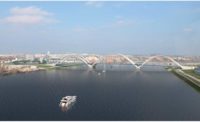The city of Anaheim is home to big-ticket draws such as Angel Stadium, the Grove arena, the Honda Center sports venue and, of course, Disneyland. Now, it is home to an iconic structure that heralds the arrival of a new age of transit in traditionally auto-centric Southern California.
Located in an area called the Platinum Triangle—targeted for mixed-use redevelopment, with an emphasis on public transportation—the 120-ft-tall, 68,000-sq-ft Anaheim Regional Transportation Intermodal Center (ARTIC) also will be the first of its kind to achieve LEED Platinum, say project officials. The goal of achieving an energy-efficient structure that also would serve as a gateway to the region—a city goal from the plan's inception—informed the painstaking design and construction efforts that belie the relatively modest $180-million cost.
"The idea was to create a great space inspired by the great rail stations of the past," says Ernest Cirangle, senior vice president with HOK, the project architect, which won a design competition in 2009 with a team led by Parsons Brinckerhoff. Unlike typical East Coast rail hubs, ARTIC's design emphasizes open views to reflect the sunny expanse of the local geography. "The city wanted an iconic building that would celebrate rail transportation in Southern California," says Cirangle.
The chosen aesthetic and environmental vision required a carefully mapped geogrid plan of unusual rigor to calculate the positions of various systems—mainly the curtain wall, ethylene tetrafluoroethylene (ETFE) roof and main entranceway, says Adam Sullivan, superintendent with general contractor Clark Construction Group. "Those enclosure systems are dictated by 15,000 geopoints [in the design model]. Each of the points has an X, Y and Z axis down to a millionth of an inch."
To maximize natural sunlight and air flows while ensuring passenger comfort despite the hot climate, the design team opted for a roof enclosure system that uses diamond-shaped pillows of ETFE. At 200,000 sq ft, the ETFE application is the largest of its kind in North America, says Michael McAlpine, project executive with STV Inc., the owner's representative.
The geometry—40 asymmetrical arches, two parabolic glass walls at the north and south ends, and metal panel walls on the sides—called for some of the most complex steel fabrication ever done by Beck Steel Inc., Lubbock, Texas, says owner John Beck, Jr. "We had to abandon any conventional methods of construction," he says. "Every piece and part of the shell structure is unique. We had to understand that conventional methods were out the window."
On the Grid
"The building doesn't look complicated," says Clark project executive David Burrus. "It looks like simple slopes. But every panel is a different size. There is nothing simple about this [so-called simple] job."
Why? "Basically you have a building that's curving in two directions," says David Herd, managing partner with BuroHappold North America, the engineer for mechanical, electrical, plumbing and the building envelope. "The building slopes from a high point on the north to a lower point on the south, and it curves from east to west. In addition, you've got the diamond-shaped ETFE balloons—you've got the structure for that, which sits over the structure of the steel. The steel bends in only one direction. So, effectively, it becomes an exercise in how you optimize the number of points to satisfy that geometry and associated shapes."
The structural-steel shell consists of 14-in. hollow steel-petroleum piping that forms the 40 arches; the arches enclose a glass curtain wall hung from 7/16-in. stainless-steel cables. The cables hang from the structural-steel columns at the north and south ends. Another system, comprising 8-ft x 8-ft aluminum-metal panels integrated with a glazing system, encompasses the east and west sides from the ground level to 36 ft high. Tolerances were held to 1/8 in. At the 36-ft mark, the ETFE roof system begins, with 160 cushions attached to some 3,000 steel supports. Tolerances of interactions among members are all in tiny fractions of an inch.















Post a comment to this article
Report Abusive Comment